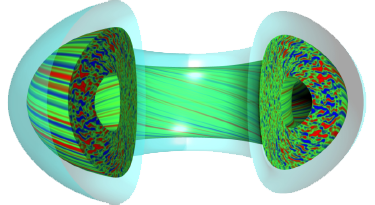Speaker
Description
Mori-Zwanzig projection operator method as a statistical correlation analysis of time-series data
S. Maeyama, M. Misawa, T.-H. Watanabe
Department of Physics, Nagoya University, Nagoya 464-8602, Japan
e-mail: smaeyama@p.phys.nagoya-u.ac.jp
Mori-Zwanzig projection operator method is a mathematical method developed in non-equilibrium statistical physics [1]. A key is a decomposition of a time propagator by the Dyson decomposition, where the time propagator is split into the projected and complementary parts based on a definition of a projection operator [2]. Using the Mori’s linear projection on initial values [1] as the projection operator, we have developed a statistical correlation analysis method for two time-series ensemble data in a statistically steady state [3]. Based on the method, the analyzed time series data $f(t)$ is split into a correlated (Markov and memory) part and an uncorrelated part $r(t)$ with regard to the variable of interest $u(t)$. The uncorrelated part $r(t)$ is characterized by the no statistical correlation with the initial value $u(0)$, namely, $\langle r(t)u(0) \rangle = 0$, where the angle brackets denote the ensemble average. There is a relation between the memory function and the uncorrelated term, known as a generalized fluctuation-dissipation theorem of the second kind.
In this presentation, we will explain the formulation of the projection operator method, the validity range of the method, and the procedure to apply the method to analyze two time-series ensemble data as a practical data analysis tool. As an example, we have analyzed the nonlinear excitation and damping of zonal flows in Hasegawa-Wakatani resistive drift wave turbulence [4]. We found that Reynolds stress of turbulence on zonal flows acts not only a stochastic forcing but also damping via the correlation with the memory term.
[1] H. Mori, Prog. Theor. Phys. 33, 423 (1965).
[2] D. J. Evans, and G. Morriss, Statistical Mechanics of Nonequilibrium Liquids (Cambridge Univ. Press, Cambridge, U.K., 2008).
[3] S. Maeyama, and T.-H. Watanabe, J. Phys. Soc. Jpn. 89, 024401 (2020); Source code is available from https://github.com/smaeyama/mzprojection.
[4] M. Wakatani, and A. Hasegawa, Phys. Fluids 27, 611 (1984).
| Country or International Organisation | Japan |
|---|---|
| Affiliation | Nagoya University |

